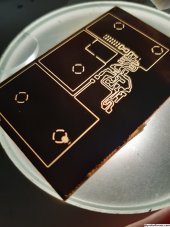yes, it helps a bit but there are always other inductances and drops, it doesn't feel safe to me to have no margin.Well, we can go up to 80 V so that gives 16 V (max is 64 V) which is always better than 10.
It is. You can imagine when you clamp exactly to battery voltage minus resistive drop. The flow into clamp will not stop and battery is feeding clamp's dissipation. It is very similar compromise you do when designing flyback clamp - you want maximal overvoltage you can afford (limits are secondary diodes) to counteract leakage inductance as fast as possible. And similarly for low clamp voltage you dissipate also voltage reflected from secondary.I'm not sure about that.
Yes it is. Nightime cry of despairThat sounds expensive and convoluted.
Are you thinking of stop FETs abruptly and when we measure big voltage over them then open them a bit in feedback to clamp it ? Or to join it into single action, rate limit closing of FETs by limiting maximal voltage over them.I had an idea: we're trying to add a FET to clamp the spike but we already have quite a few FETs that are very capable (each can handle 300 A for seconds if needed, so 3 kA minus some margin to account for uneven load sharing) so why not use those? The only problem is the already in-circuit gate driver but I'm pretty sure it's a solvable problem.
It is what I have done now. I used fixed ramp over 1us to minimize overvoltages. But still FETs were blown. It is elegant solution with these drawbacks:
1/ Vth is badly controlled parameter in FETs; once you parallel FETs and use them in active region (as opposed to self-stabilizing saturation region) there will be big differences in current between them, probably leading to cascade failure; solution is either source ballast resistors (not viable here) or feedback driver per FET
2/ I'd like to avoid meddling with main switch FETs in linear mode (I planned to do it for precharge before but now I think more of PWM precharge) because failure of single FET means no protection of battery. And quite likely sequence is: inverter's main resistive divider fails (there is second comparator for big overvoltage) -> it starts to overcharge battery at normal current (no fuse will fail) -> BMS detects and instructs disconnect -> slow switch close and inverter continues to increase output voltage as response (up to 63V safety limit of my one) -> one fet fails -> battery catches fire later; I somehow feel the FETs are quite critical and I should do my best to make sure I prepare them suitable working environment - or maybe I'm just too paranoid
3/ testing; the clamp I designed above is crude idea. It needs to be verified under various currents, voltages, slew rates, presence of AC on voltage bus, components tolerances; when you combine this with need to cope with 2 anti-series FETs, per FET Vth control, and extra control from MCU then validating it starts to look like man-months projects itself; I'm not afraid of complexity in non-critical areas but this is going to be real time hog





